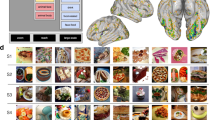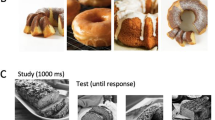Abstract
Choosing what to eat is a complex activity for humans. Determining a food’s pleasantness requires us to combine information about what is available at a given time with knowledge of the food’s palatability, texture, fat content, and other nutritional information. It has been suggested that humans may have an implicit knowledge of a food’s fat content based on its appearance; Toepel et al. (Neuroimage 44:967–974, 2009) reported visual-evoked potential modulations after participants viewed images of high-energy, high-fat food (HF), as compared to viewing low-fat food (LF). In the present study, we investigated whether there are any immediate behavioural consequences of these modulations for human performance. HF, LF, or non-food (NF) images were used to exogenously direct participants’ attention to either the left or the right. Next, participants made speeded elevation discrimination responses (up vs. down) to visual targets presented either above or below the midline (and at one of three stimulus onset asynchronies: 150, 300, or 450 ms). Participants responded significantly more rapidly following the presentation of a HF image than following the presentation of either LF or NF images, despite the fact that the identity of the images was entirely task-irrelevant. Similar results were found when comparing response speeds following images of high-carbohydrate (HC) food items to low-carbohydrate (LC) food items. These results support the view that people rapidly process (i.e. within a few hundred milliseconds) the fat/carbohydrate/energy value or, perhaps more generally, the pleasantness of food. Potentially as a result of HF/HC food items being more pleasant and thus having a higher incentive value, it seems as though seeing these foods results in a response readiness, or an overall alerting effect, in the human brain.



Similar content being viewed by others
Notes
Given that this analysis was post hoc, the number of stimuli for each participant was not the same for each condition. For the fat analysis, there were 40 RTs that were averaged for each of the 18 conditions, while in the carbohydrate content analysis, there were 29–50 RTs averaged for each condition.
References
Baumeister RF, Bratslavsky E, Finkenauer C, Vohs KD (2001) Bad is stronger than good. Rev Gen Psychol 5:323–370
Brignell C, Griffiths T, Bradley BP, Mogg K (2009) Attentional and approach biases for pictorial food cues. Influence of external eating. Appetite 52:299–306
di Pellegrino G, Magarelli S, Mengarelli F (2011) Food pleasantness affects visual selective attention. Q J Exp Psychol 64:560–571
Klein R (2000) Inhibition of return. Trends Cogn Sci 4:138–147
Knebel JF, Toepel U, Hudry J, Le Coutre J, Murray MM (2008) Generating controlled image sets in cognitive neuroscience research. Brain Topogr 20:284–289
Mogg K, Bradley BP, Hyare H, Lee S (1998) Selective attention to food-related stimuli in hunger: are attentional biases specific to emotional and psychopathological states, or are they also found in normal drive states? Behav Res Ther 36:227–237
Morris JS, Dolan RJ (2001) Involvement of human amygdala and orbitofrontal cortex in hunger-enhanced memory for food stimuli. J Neurosci 21:5304–5310
Nummenmaa L, Hietanen JK, Calvo MG, Hyönä J (2011) Food catches the eye but not for everyone: a BMI–contingent attentional bias in rapid detection of nutriments. PLoS ONE 6(5):e19215
Piech RM, Hampshire A, Owen AM, Parkinson JA (2009) Modulation of cognitive flexibility by hunger and desire. Cogn Emot 23:528–540
Piech RM, Pastorino MT, Zald DH (2010) All I saw was the cake. Hunger effects on attentional capture by visual food cues. Appetite 54:579–582
Posner MI (1978) Chronometric explorations of mind. Lawrence Erlbaum, Hillsdale
Spence C (2010) Crossmodal spatial attention. Ann N Y Acad Sci 1191:182–200
Spence C, MacDonald J, Driver J (2004) Exogenous spatial-cuing studies of human cross-modal attention and multisensory integration. In: Spence C, Driver J (eds) Crossmodal space and crossmodal attention. Oxford University Press, Oxford, pp 277–320
Sumner P, Mollon JD (2000) Catarrhine photopigments are optimized for detecting targets against a foliage background. J Exp Biol 203:1963–1986
Talmi D, Seymour B, Dayan P, Dolan RJ (2008) Human pavlovian–instrumental transfer. J Neurosci 28:360–368
Toepel U, Knebel JF, Hudry J, le Coutre J, Murray MM (2009) The brain tracks the energetic value in food images. Neuroimage 44:967–974
West G, Anderson A, Pratt J (2009) Motivationally significant stimuli show visual prior entry: direct evidence for attentional capture. J Exp Psychol Hum Percept Perform 35:1032–1042
Acknowledgments
Vanessa Harrar holds a Mary Somerville Junior Research Fellowship. Ulrike Toepel and Micah Murray receive support from an interdisciplinary project awarded by the Faculty of Biology and Medicine at the University of Lausanne. Micah Murray receives support from the Swiss National Science Foundation (grant 310030B-133136). Thanks to Jean-Francois Knebel for providing help with the image selection and preparation.
Author information
Authors and Affiliations
Corresponding author
Rights and permissions
About this article
Cite this article
Harrar, V., Toepel, U., Murray, M.M. et al. Food’s visually perceived fat content affects discrimination speed in an orthogonal spatial task. Exp Brain Res 214, 351–356 (2011). https://doi.org/10.1007/s00221-011-2833-6
Received:
Accepted:
Published:
Issue Date:
DOI: https://doi.org/10.1007/s00221-011-2833-6




